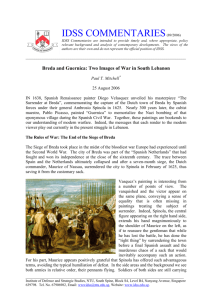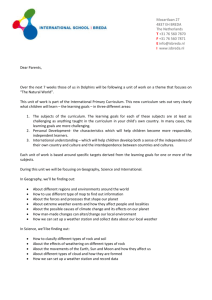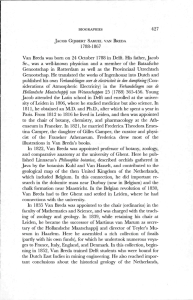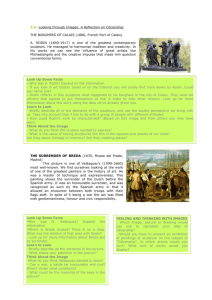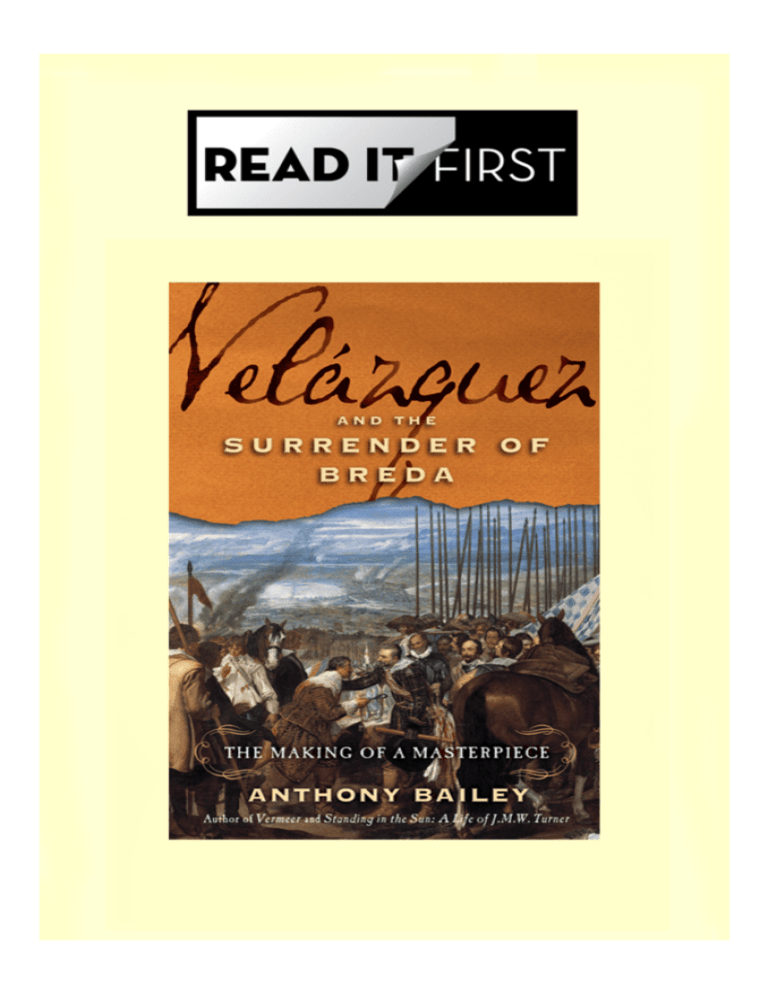
Henry Holt and Company, LLC
Publishers since 1866
175 Fifth Avenue
New York, New York 10010
www.henryholt.com
Henry Holt® and
® are registered trademarks of Henry Holt and Company, LLC.
Copyright © 2011 by Anthony Bailey
All rights reserved.
Library of Congress Cataloging-in-Publication Data
Bailey, Anthony, 1933–
Velázquez and the surrender of Breda / Anthony Bailey.—1st ed.
p. cm.
“A John Macrae book.”
Includes bibliographical references and index.
ISBN 978-0-8050-8835-9
1. Velázquez, Diego, 1599–1660. 2. Painters—Spain—Biography.
Diego, 1599–1660. II. Title.
ND813.V4B26 2011
759.6—dc22
[B]
Henry Holt books are available for special promotions and premiums.
For details contact: Director, Special Markets.
First Edition 2011
Designed by Meryl Sussman Levavi
Printed in the United States of America
10
9
8
7
6
5
4
3
2
1
I. Velázquez,
I. The Turfship. Breda. 1590
T
he wing of a butterfly beats, we are told, and a million aftereffects later, far away, a tidal wave happens. In the chain
of causation that matters here, what could be taken for a starting point
was not an insect wing-beat but a spade cut, as a rectangular piece of
peat was sliced from soggy ground and placed onto a barrow from which
it was then loaded onto a high-sided barge, heaped up, turf upon turf,
in a pile that resembled an earthen shed, hollow inside, though only a
few were aware of this fact. From the riverbank, where the loading was
taking place, the ship’s cargo looked like a solid stack. The river was the
Mark; it flowed northward through Brabant, a province in the Netherlands, to join the much larger river Waal, and thence out to the North
Sea. The time was the beginning of March, 1590, a gray morning, and
a war was going on. Despite this the scene near Zevenbergen seemed
utterly peaceful as, the next day, the barge’s sails were hoisted and—
think of a painting by the Dutch artist Jan van Goyen—the turfship
set off up the Mark toward the town of Breda, past the diked green
meadows in which cattle grazed.
One man, one of the only two visible crew members, stood in the
bow while the skipper sat on a bench at the stern, holding the oak tiller
against his hip, and listening to the rustle of water as it curved around
the plump sides and the barn-door rudder and fell away astern without
disturbance. There had been a heavy frost the night before and the air
Q2R
Velázquez and The Surrender of Breda
was damp. But during the next few hours the breeze freshened, the wetness dissipated, and the mainsail was reduced in area by being brailed
up at the front bottom corner between mast and boom. Nevertheless
Adriaan van Bergen, the skipper, thought it better to keep going with
the flood tide under them. Every now and then a figure could be seen
on the riverbanks, probably a cowherd or farmer, so far at least no soldiers from the outposts of the Spanish Army of Flanders. Before the
ship came abreast of these strangers the man on the foredeck leaned
down and loudly whispered, seemingly at the peat, the word “Silence!”
Not that you could hear much up on deck. The seventy or so men
crouched below were indeed silent, pent up with their thoughts. They
huddled together in almost total blackness, communicating by nudges
and gestures, hands touching shoulders, occasionally reaching out to
make sure their weapons were still there, within reach, on the barge’s
hefty ribs and the bottom boards that lined the hold. The few cracks in
the stacked-up peat gave just enough light and air. It was the lack of air
rather than of light that most affected the party; the strong thick smell
of the peat made it feel like being buried in a compost heap, and the
need to swallow or—worse—sneeze and cough occasionally overcame
them.
It was Adriaan van Bergen’s turfship. But its mission had been an
idea floated before, by the late William of Orange, the revered if somewhat reluctant leader of the revolt against the Spanish overlords of the
Netherlands. William had taken note of the fact that turf skippers
could enter the walls of the occupied town of Breda most easily. Breda
had been the home territory of the Orange-Nassau family. William,
nicknamed the Silent because of his cautious habit of thinking a long
time before acting, lips sealed, had fallen to an assassin’s gun in Delft
six years before, but his son and heir, prince Maurice, had taken up the
turfship idea. He had made inquiries about an experienced skipper
and van Bergen, one of a family of turf handlers from Leur, was recommended. Van Bergen also had a big enough ship. The Spanish had
captured Breda in 1581, killing six hundred of its citizens and plundering
the place; they had occupied it ever since, and Maurice was impatient
to regain it. It was not only his family seat but a key link in the ring of
walled towns and forts with which Spain encircled the northern rebel-
The Turfship. Breda. 1590
Q3R
lious provinces. The winter still not quite over had been a tough one; it
was a matter of waiting for the castle garrison or town council to order
a new load of fuel, which they must do soon. Meanwhile an assault force
was put together. An experienced officer from Cambrai in the southern
Netherlands, the mostly Spanish Netherlands, thirty-four-year-old
Charles de Héraugiere, who wanted to prove his loyalty to the OrangeNassau family, was given the command. Several meetings took place at
secret locations to work out how and when the men would be embarked
on the turfship. The unit was recruited by Count Philip van Hohenlohe, a relative of Maurice’s by marriage, and Maurice from his palace
at The Hague organized a force of about 4,600 men of the States army
to be ready to take over the city if the surprise initial attack led by de
Héraugiere was successful.
At the end of February 1590 it became known that a new shipment
of peat had been ordered by Breda. Maurice—who was twenty-three—
set off with his small army toward Dordrecht, although, because of
spies everywhere, he attempted to get it known that he was going somewhere else. Gorinchem was mentioned. The governor of Breda, an Italian named Lanciavecchia, led an opposing force of the king of Spain’s
Army of Flanders toward Geertruidenberg, northeast of Breda, on the
edge of the large area of river and swamp known as the Biesbos, thinking Maurice was heading there. In this time of haste and flurries of
misinformation, the first attempt to embark the assault force went
wrong; the blame fell on the skipper for “oversleeping” though overdrinking was more likely. The river Mark was tidal up to Breda and
very low water then kept the turfship immobile for several days. But on
the afternoon of Friday, March 2, the decision was made to go for it. On
the following day van Bergen’s heavily laden ship sailed up the channel
to the north of a small island named Reygersbosch. Here a moveable
barrier or boom controlled passage to the canal surrounding Breda’s
castle. Here guards waited in an outpost, and a brief inspection took
place led by an Italian corporal, the guards seeing that the ship obviously
carried the expected peat shipment. Then there was an uneasy period
of waiting for the tide to rise high enough so that the ship could be
moved in through the water gate. This was the worst time, the Dutch
soldiers uneasy under their stack of peat, the leaky ship’s bilges slowly
Q4R
Velázquez and The Surrender of Breda
filling with water that would soon need pumping out, de Héraugiere
murmuring encouraging words to keep spirits up. But just after three
p.m. the tide served. The ship’s mast was lowered and the vessel was
poled toward the quayside. Van Bergen now pumped away, the noise
disguising some coughs coming from within the peat. At the quay a
squad of Italian soldiers hauled on warps to bring the turfship in through
a sort of tunnel under the walls to a sluis or lock that controlled the
water level and thence into the little harbor within the castle. There
the ship was moored alongside the arsenal. An impatient squad from
the garrison climbed aboard to start unloading the peat.
“What’s the hurry?” Adriaan van Bergen wanted to know. The
beginning of Lent was approaching and a drink or two surely wouldn’t
come amiss. There was all day tomorrow to unload the cargo. To reinforce this idea he doled out some coins to the soldiers and the suggestion
worked. Most of the garrison men went off to a hostelry in the town or
to their barracks. Only one Italian was left on guard but he too was plied
with beer and by midnight he was asleep. It was a quiet night. When van
Bergen gave the word that the time was right, de Héraugiere’s band
silently climbed out from their peat stack one by one, adjusting their
helmets and cuirasses, unsheathing their swords and axes, priming their
guns, and formed up in two groups. The sleeping guard was knocked
on the head and rendered truly unconscious. One party went toward
the bastion by the harbor and the northwest gate. The other, led by de
Héraugiere, headed for the gate that gave entry into the town. On the
way they encountered a guard, who, surprised, at least remembered to
ask “Qui va là?” The Dutchmen seized him and questioned him about
the garrison, its size and its whereabouts. The facts were that the town
was guarded by six companies formed by citizens and five vendels, which
were mostly Italian. The castle itself was garrisoned only by a unit of
some fifty men, led by the son of the governor, Paolo Antonio Lanciavecchia.
The Italian who was being questioned gave erratic answers: any
number or location that came into his terrified head. He was killed.
But the lethargic watch had now woken up. The alarm was sounded.
Short battles took place at the guard houses by the outer gates. Those
inside were shot through the windows. Young Lanciavecchia’s men
The Turfship. Breda. 1590
Q5R
made a counterattack, but this was repelled. Their colleagues who had
been partying in town tried to burn the outer gate but were forcibly
prevented. Mopping up went on for some time, but by dawn the victory
was evident. Thirty-seven Italians lost their lives and among the insurgents only one Dutchman, Hans van den Bosch, who fell into a canal and
drowned. A number on both sides were badly injured. Paolo Lanciavecchia managed to negotiate the surrender of himself and some of his
men, paying a hefty ransom. On the north side of the castle, the field
gate was found to be frozen shut—warming it up by fire might have
helped—but it was finally prized open and van Hohenlohe’s vanguard
let in, the first contingent of Maurice’s small army. Trumpets sounded
the Dutch anthem, the “Wilhelmus.” Breda had been taken. The flags
of Spain were hauled down and burned.
The burghers and magistrates of Breda thought it advisable to show
how pleased they were. Bells were rung and thanksgiving ser vices
held in the Groot Kerk near the market square and in the many other
churches in town. As the news spread, bonfires were lit in celebration
all over the northern Netherlands. A feast was held in one of the town’s
best inns for the van Bergens, owners of the turfship, and its skipper,
Adriaan van Bergen, who was given an annual pension and made a
lockkeeper in Breda. De Héraugiere was given a set of pewterware, a
gold-plated model of the turfship, and an even bigger pension. Many
of the citizenry of the town who had enjoyed the royal, Catholic status
quo tried to hide their chagrin at the turn of events, their fury at the
failure of the king of Spain’s army to defend Breda against the States
rebels. Any remaining Italian or Spanish civilians fled town. The town
had to cope with the sudden inrush of Maurice’s 4,600 men, who
included an English contingent under Sir Francis Vere, and a new governor (de Héraugiere for a period and then Maurice’s half brother,
Justin). The citizens of Breda were scared of looting and the imposition
of fierce financial exactions. To alleviate their concern the town council negotiated a cash payment to take the place of the plundering generally permitted a victorious occupying force. Sixteen thousand guilders
was the amount first agreed upon, but this was soon raised to 87,000
guilders. Breda couldn’t afford this demand and the States General in
The Hague had to make good the bill. The town moreover had to pay
Q6R
Velázquez and The Surrender of Breda
for the billeting, board, and lodging of the prince’s troops. The citizenry
also suffered the fate of collaborators everywhere; there was a decided
loss of face; the feeling was common in the northern Low Countries
that the Baronie, the name for the whole district of Breda, wasn’t participating staunchly enough in the opstand, the revolt against Spain.
As for the so-called defenders of Breda for the king of Spain, it was
trouble. The royal governor of the Low Countries, the Duke of Parma,
court-martialled those responsible. The Italian corporal accused of letting in the turfship and two of his superior officers were beheaded in
Brussels. Young Lanciavecchia was dismissed from his command. Bolting the stable door after the surprise break-in, Count Karel van Mansfelt, the commander of the Army of Flanders, was ordered to ensure
that Breda was properly locked up. One effect of this was that Adriaan
van Bergen’s turfship was stuck inside the city walls. Unattended,
without constant pumping, it would have sunk and blocked the canal;
it was therefore hauled out onto the quay by the castle, a roof built over
it, and on every fourth of March for the next thirty-five years featured in
civic celebrations.
in 1590 the confl ict was already mature and getting older. What
would become known as the Eighty Years War between the Dutch
United Provinces and the Spanish empire had begun in 1568. Like
many historic European wars, it would beggar understanding, causing
as it did an immense loss of men’s labor, the capital of nations, and
human life; like many other such conflicts, it was sparked by rivalry over
trade, control of overseas possessions, by religious dissent and dynastic
dissatisfactions. The way royal families extended their power by inheritance was much to blame. A simplified family tree has Hapsburg possessions being first brought together in 1477 when Maximilian, son of
the emperor of Germany, married Mary of Burgundy, and in time
became regent of the Netherlands. Their son Philip married Juana,
daughter of King Ferdinand (of Aragón) and Queen Isabella (of Castile). The elder son of Philip and Juana was Charles, born in the Netherlands and boasting the protruding Hapsburg lower lip, who married
Isabella of Portugal and inherited an empire that, despite its panEuropean and indeed eventually worldwide extent, had many fault
The Turfship. Breda. 1590
Q7R
lines. Charles V ruled a diverse conglomeration of countries in which
what the historian H. A. L. Fisher called the “old medieval unity of
faith” was being tugged apart by vehement forces, sometimes under
monarchical leadership, sometimes in the guise of religion, sometimes
fired by early nationalistic fervor. Charles—who started out knowing
no Spanish—slowly became a Spaniard; keeping an empire together
and without heresy was a full-time job from which he finally abdicated
in 1555, worn out, immobilized by gout, and for the occasion leaning on
the shoulder of one of his Low Countries noblemen, the young Prince
of Orange.
Charles retired to a remote Spanish monastery, his cell decorated
with a Titian Gloria. His son Philip II was Spanish to the core, a devout
Catholic, keen on destroying heretics with the help of the Inquisition.
He insisted on only the plainest music. The times were hard on dissent:
The works of Erasmus were banned; the Utrecht painter Antonis Mor,
who had been working at the Hapsburg court, fled from Spain back to
Antwerp in the Netherlands. Philip II also had a formidable army, the
Spanish tércios providing him with the best infantry battalions in Europe,
and he possessed a massive navy. However, despite its success with
almost obsolete Mediterranean galleys at Lepanto in 1571, his armada
against England came up against skilled sailors in oceangoing ships in
the Channel and North Sea seventeen years later—resulting in an English
victory over Spain that had the effect of leaving the Dutch rebels in
command of the coasts of the Low Countries.
The Dutch had grasped the idea that free trade was the fount of
prosperity. Banking came as naturally to Amsterdam as it had to Antwerp. Spain was hopeless at finance, inept with taxation, both the
Spanish church and the nobility accustomed to exemptions, the country
expecting its trade to benefit from protection when what would have
most helped was freedom to ship anything anywhere. An increasingly
uncertain prop for Spanish power was furnished by the mineral wealth
of Mexico and Peru. These riches were diminished on their way to the
royal treasury by enemy fleets, shipwreck, peculation, inflation, and
sales taxes like the alcabala, which struck at the commercial energies of
the very people who most needed to be given heart.
In the Netherlands, the tax that did immediate harm was the tenth
Q8R
Velázquez and The Surrender of Breda
penny—the Spanish commander the Duke of Alba’s local version of
the alcabala. It was in Breda castle in 1566 that what was called a compromise but was in fact a statement of intent was signed by many of the
Netherlands nobility, demanding the abolition of the Inquisition in the
Low Countries. From there a delegation went to Brussels to ask the governor, Margaret of Parma, to convoke the States General assembly and
moderate the injunctions against Protestants. It was there that Margaret’s counsellor, Berlaymont, famously exclaimed to his distressed
leader, “What, Madam, afraid of these beggars!”—an abusive term triumphantly taken on as a compliment by those who had signed the Breda
Compromise. While opposition to Spanish financial exactions and religious persecution mounted, and as the counts Egmont and Hoorn, two
noble dissidents, were tried in Alba’s “Courts of Blood” and executed in
Brussels in 1568, William of Orange tried to maintain that he was a
rebel against misgovernment, not against his monarch, Charles V’s son
Philip II. The writer of the “Wilhelmus,” the anthem written about this
time that became the Dutch national hymn, declared for all to sing, as
though making a distinction between disloyalty and necessary dissent:
Unto the Lord His power
I do confession make
That ne’er at any hour
Ill of the King I spake.
But unto God, the greatest
Of Majesties, I owe
Obedience first and latest,
For justice wills it so.
One further thing in common: The kings of Spain claimed to be
ruling in direct succession to the kings of Israel, and the princes of
Orange adopted a similar biblical camouflage, declaring their descent
from the House of Judah. Both nations were therefore chosen people.
the fact that the Dutch revolt against Spain was a conservative
revolt, against Spanish authority though not against the king of Spain,
didn’t prevent the Spanish crackdown from being terrifying. Fernando
The Turfship. Breda. 1590
Q9R
Álvarez de Toledo, the Duke of Alva, was a believer in shock and awe.
The duke thought Holland was “as near to hell as possible” and took it
out on the inhabitants of the Low Countries. Property was seized,
rebels and heretics arrested and executed, and entire cities such as Antwerp sacked. For many years after that in Spain itself any sort of inhuman behavior could provoke the question: “¿Estamos aquí o en Flandes?”
Are we here or in Flanders? The troops of Alva and his son Don Fadrique
raped, murdered, looted, and burned their way through Malines,
Zutphen, and Naarden, though Haarlem took seven months to fall in
1573, and Alkmaar actually repulsed the Spaniards that same year: It
could be done. Leiden also held out against a long Spanish siege. At
Breda, the surprise Dutch turfship counterattack worked. By then the
Netherlands were effectively sundered. In 1579 the Union of Utrecht
brought together the northern provinces and three years later their
representatives formally renounced their allegiance to the king of Spain.
The southern provinces, united by treaty at Arras, developed a sort of
autonomy under their new governors, Isabella, Philip II’s daughter,
and her husband, Archduke Albert of Austria. By 1590 indeed the era
of Spanish beastliness was mostly past. The war seesawed on for another
fourteen years. The Duke of Parma, an able and less savage general
than Alva, was held up by the equally smart tactics of Maurice of Nassau, William of Orange’s oldest son, by the fact that Philip of Spain
made the great mistake of taking on at once the English and French
(both of whose nations were involved in civil war), and by diverting
Spain’s strained resources into the armada. Parma was also impeded by
the clever use the Dutch made of water, which seemed to be their natural element: whether the sea or the great rivers that penetrated deeply into
the lowlands. Fresh or salt, water held up and diverted—even if it didn’t
stop—the armies of Spain. The States of Holland declared in 1596: “In
the command of the sea and in the conduct of the war on the water
resides the entire prosperity of the country.” So much so that the Hollanders continued sending their ships to trade with the Spanish while
the war went on.
Probably the biggest factor, at the turn of the century, that tilted
the balance slightly in favor of the United Provinces was money, or in
Madrid the lack of it. The Dutch flourished abroad, in the northern
Q 10 R
Velázquez and The Surrender of Breda
oceans and the Spice Islands, overseas trade creating great wealth at
home. The Sea Beggars of Zeeland throttled the Scheldt, the approaches
to Antwerp, and thousands of Antwerp’s citizens (including Frans
Hals’s parents) left that city for the north, some for religious reasons,
many because they had no longer any way of making a living there.
(The Halses went to Haarlem.) Off Gibraltar in 1607 at the southwest
tip of Spain a Dutch fleet convincingly defeated the Spanish. The northern united provinces consolidated as a federal entity, the Dutch Republic,
governed from The Hague, with the province of Holland and the leaders of its oligarchy in prime control. Yet the Spanish weren’t completely
out of it. A three-year siege by their Army of Flanders succeeded in
reducing Ostend, and the name of their Genoese general, Ambrogio
Spinola, began to be much heard. (Genoa was in Spanish Hapsburg
territory.) Spinola came from a great banking family, and often had to
provide his own backing to finance Spain’s armies, but he had a Renaissance condottiere’s broad understanding of military endeavor, encompassing engineering, diplomacy, and hands-on skill in the field; this
helped Spain stem the Dutch drive under Maurice to create a modern,
efficient army, second largest in Europe and in receipt of helpful subsidies from France. By 1609 a balance of power was reached; successes
and failures had canceled each other out; a new king in Spain, Philip
III, had taken the place of his austere and autocratic father; in the Low
Countries Philip’s sister Isabella and her husband, Albert, ruled jointly
in Brussels and introduced a new sense of moderation. The stalemate
led to rumors of peace and then a truce. This lasted twelve years.
VELßZQUEZ AND THE
SURRENDER OF BREDA
BUY THE BOOK NOW
Amazon
Barnes & Noble
IndieBound
LEARN MORE ABOUT THE BOOK
macmillan.com


